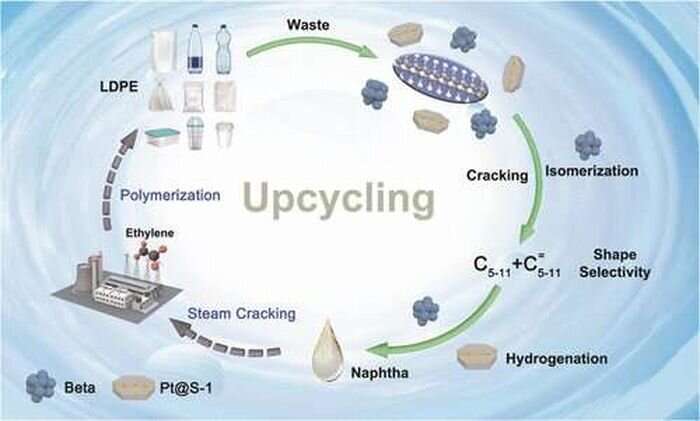This article has been reviewed according to Science X's editorial process and policies. Editors have highlighted the following attributes while ensuring the content's credibility:
fact-checked
peer-reviewed publication
trusted source
proofread
Effective and reusable tandem catalyst developed for plastic waste conversion

The rapid growth of plastic waste is an ever-growing environmental and energy challenge. Selectively converting waste plastics to naphtha, a main feedstock for ethylene and the plastic industry, shows high potential to partially replace petroleum-route naphtha and alleviate global net carbon emissions.
However, these active metals on supported catalysts with an open microenvironment showed less effect on the generation of intermediates and selectivity of naphtha.
Recently, a research group led by Prof. Wang Hui and Assoc. Prof. Luo Hu from the Shanghai Advanced Research Institute of the Chinese Academy of Sciences proposed a tandem catalytic reaction to efficiently convert low-density polyethylene (LDPE) into naphtha. In this reaction, a naphtha yield of 89.5% was obtained with 96.8% selectivity of C5-C9 hydrocarbons at 250 °C, catalyzed by mechanically mixed β zeolite and Pt@S-1 catalysts.
The study was published in Journal of the American Chemical Society on Jan. 12.
The selectivity of normal alkanes catalyzed by Pt@S-1 and β zeolite reached 34%, about 10–20% higher than that on Pt/S-1, and the alkane products were narrower. The differences between the two catalysts were possibly due to the confinement effect and shape-selectivity of Pt@S-1.
Combining density functional theory and molecular dynamics simulations, the researchers found that during the shape-selectivity process, the diffusion and shipping of olefin intermediates with the right size were boosted within Pt@S-1, which led to narrower-distributed products.
This catalyst system displayed stability and high performance for most abundant plastic waste like low-/high-density polyethylene and polypropylene at moderate conditions. Compared with conventional routes for plastic production, this approach showed 15% energy saving and 30% reduced greenhouse gas emissions.
More information: Lin Li et al, Converting Plastic Wastes to Naphtha for Closing the Plastic Loop, Journal of the American Chemical Society (2023). DOI: 10.1021/jacs.2c11407
Journal information: Journal of the American Chemical Society
Provided by Chinese Academy of Sciences





















